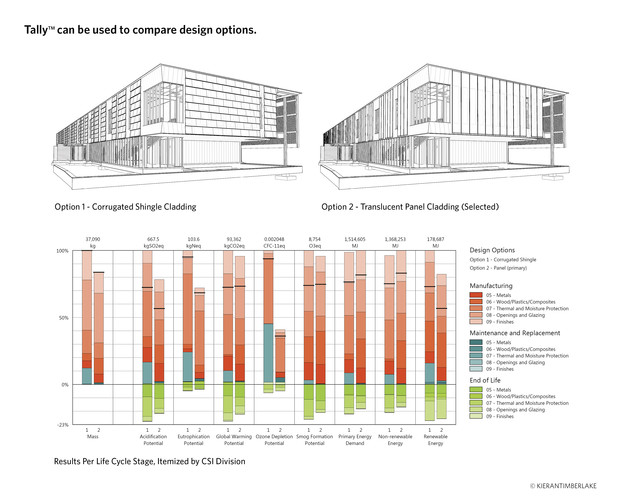
With demand for whole-building life-cycle assessment (LCA) increasing, a partnership of architects, LCA experts, and software developers has worked to release Tally—a new tool that allows designers to track environmental impacts in real time while creating models in the popular building information modeling (BIM) software Revit. Created by KieranTimberlake, PE International, and Autodesk (developer of Revit), the tool is currently being offered as a free public beta release.
“The really exciting thing about this tool is that it was developed by architects, for architects,” says Heather Gadonniex, director of business development at PE International. She clarifies that the tool is focused on embodied impacts from the entire life cycle of building products and materials—also the focus of the new LEED v4 credit relating to whole-building LCA—and doesn’t cover impacts from construction or operation of the building. “It’s not an energy modeling tool,” she explains—so adding two extra inches of insulation will likely increase embodied impacts in Tally, but only an energy model can determine whether better energy performance will offset those increases over the building’s life.
Drawing from the massive GaBi LCA database developed by PE, Tally does account for impacts from material resource extraction, manufacturing, transportation to the jobsite, use and maintenance, and disposal or recycling. “It certainly is a big step towards making LCA more accessible and putting it into a process that we already have,” notes Frances Yang, a structure and sustainability specialist with the international engineering firm Arup. “I really like how you’re building off what designers have already put work into, and you don’t have to re-create the model.”
LCA is only as good as the data that informs it, and Yang praised the testing and third-party validation the developers have pursued. However, she adds, “There’s still not as much transparency about the data” as some professional LCA practitioners might prefer. Yang also points out that there may be a learning curve for designers because they will need to assign materials and quantities fairly early on in the design process—and possibly with more precision than they’re used to. Additionally, “The systems are pretty much decided on by the time you do the model,” she says, so if project teams aren’t comparing structural systems using life-cycle analysis very early in the design process, they might miss some major opportunities. Although designers can still reduce impacts in a variety of ways after modeling begins, other tools are a better fit for the earliest decision-making, Yang suggests.
“Really, we’ve been seeing kind of a pent-up demand for this type of tool over the past few years,” Gadonniex states. “It’s pretty exciting because there are some firms that have in-house specification team members who understand the LCA tools enough to utilize those, but we really wanted to be able to help the architects and designers to understand the environmental footprint by integrating the data in their tool.” She hopes the application will “empower them to make smarter purchasing decisions.”
KieranTimberlake is offering video tutorials of Tally on its website to give designers a preview of how it works.

Post a comment to this article
Report Abusive Comment